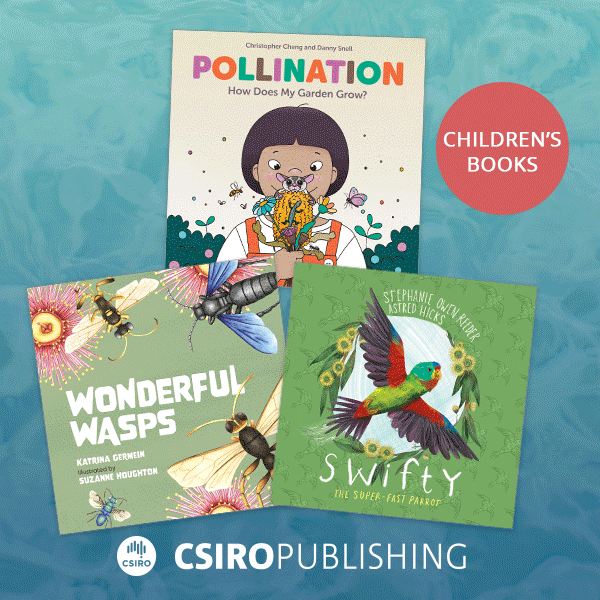 Happy Bilby Day (September 12th)! Let’s get muddy and investigate what makes up different soils. Along the way, you’ll learn how bilbies play an important role in improving Australia’s soils.
Happy Bilby Day (September 12th)! Let’s get muddy and investigate what makes up different soils. Along the way, you’ll learn how bilbies play an important role in improving Australia’s soils.
Safety: ![]()
![]() This activity involves touching soils. Watch out for any sharp objects in soil and wash hands thoroughly after this activity.
This activity involves touching soils. Watch out for any sharp objects in soil and wash hands thoroughly after this activity.
You will need
- Garden trowel
- 3 to 4 paper or plastic cups
- 2 large aluminium or plastic containers
- 1 glass of water
- Garden gloves (optional)
- Whiteboard marker (optional)
What to do
- Identify 3 to 4 different spots outside your home where you can collect some soil samples, such as near a tree, on a lawn, near rocks or bare ground. Double check with an adult if these spots are okay to dig.
 Grab your trowel and collect about half a cup of soil from each of the different spots around your home. Ask an adult to help if the soil is too firm for digging. If you have a marker, you can label each of your cups with where you found the soil from.
Grab your trowel and collect about half a cup of soil from each of the different spots around your home. Ask an adult to help if the soil is too firm for digging. If you have a marker, you can label each of your cups with where you found the soil from. Pour some soil from a cup into one of your aluminium or plastic containers. Remove any big chunks of debris such as twigs and gravel from the soil. If you have gloves, you can put them on before doing this.
Pour some soil from a cup into one of your aluminium or plastic containers. Remove any big chunks of debris such as twigs and gravel from the soil. If you have gloves, you can put them on before doing this. Then, slowly pour water into the container and mix it with the soil using your trowel until you can make a muddy paste.
Then, slowly pour water into the container and mix it with the soil using your trowel until you can make a muddy paste.- Take a handful of the muddy paste and mash it up in your palm until it forms a round ball.
 Use your thumb and index finger to “pinch” the ball into a wide ribbon of soil about 2 to 3 millimetres thick. When the soil ribbon starts to crack or break, place that into your second container.
Use your thumb and index finger to “pinch” the ball into a wide ribbon of soil about 2 to 3 millimetres thick. When the soil ribbon starts to crack or break, place that into your second container. Repeat steps 3 to 6 for your remaining cups of soils. Do you notice if different soil samples form different lengths of ribbons? You can rinse out your cups and containers if you want to do this activity again at a friend’s house and see what you find!
Repeat steps 3 to 6 for your remaining cups of soils. Do you notice if different soil samples form different lengths of ribbons? You can rinse out your cups and containers if you want to do this activity again at a friend’s house and see what you find!- Remember to wash your hands thoroughly when you’re done!
What’s happening?
Soil isn’t just “dirt”. There are 3 main non-living parts in soil: sand, silt and clay. Clay is the smallest particle out of the 3, so it has the most surface area to absorb more water compared to silt and sand. This makes clay soils the stickiest. If you made a long ribbon, then you’ve found a clay-y soil!
If you felt any gritty bits in your soil, that’ll be the sand particles. As the biggest particle compared to silt and clay, sand grains create gaps in soils. Because of these gaps, sand doesn’t stick together well and it lets water through quickly, so sandy soils will give you shorter ribbons.
Soil is also made up of living parts: plants, bugs, bacteria and decomposed materials called organic matter. If you dug up a soil sample near a plant, your soil ribbon would have felt “fluffy” to you. This is because organic matter adds gaps in soil like sand particles. But unlike sand, organic matter can hold onto water and nutrients better. As a result, it acts like a glue between sand, silt and clay particles to give plant roots gaps to grow and breathe, plus water and nutrients!
For most plants, they need the right balance of clay, silt, sand and organic matter to grow. After all, you don’t want soil to be so sticky that plant roots don’t have gaps to grow through, nor so sandy that roots can’t stay hydrated!
Bilbies are soil heroes

Male bilbies weigh up to 2.5 kilograms and females weigh up to 1.1 kilograms, yet a single bilby can dig up several tonnes of soil a year!
Credit: ©iStock.com/Ken Griffiths
The greater bilby is a small but keen digger. Every night, they look for food by digging deep holes. This mixes organic matter with other particles in deeper soil layers. This also mixes seeds from the soil surface with more nutrients and water, giving them better chances to grow and add more life to soils. In turn, this means more homes for other wildlife, and better health for the environment!







Leave a Reply